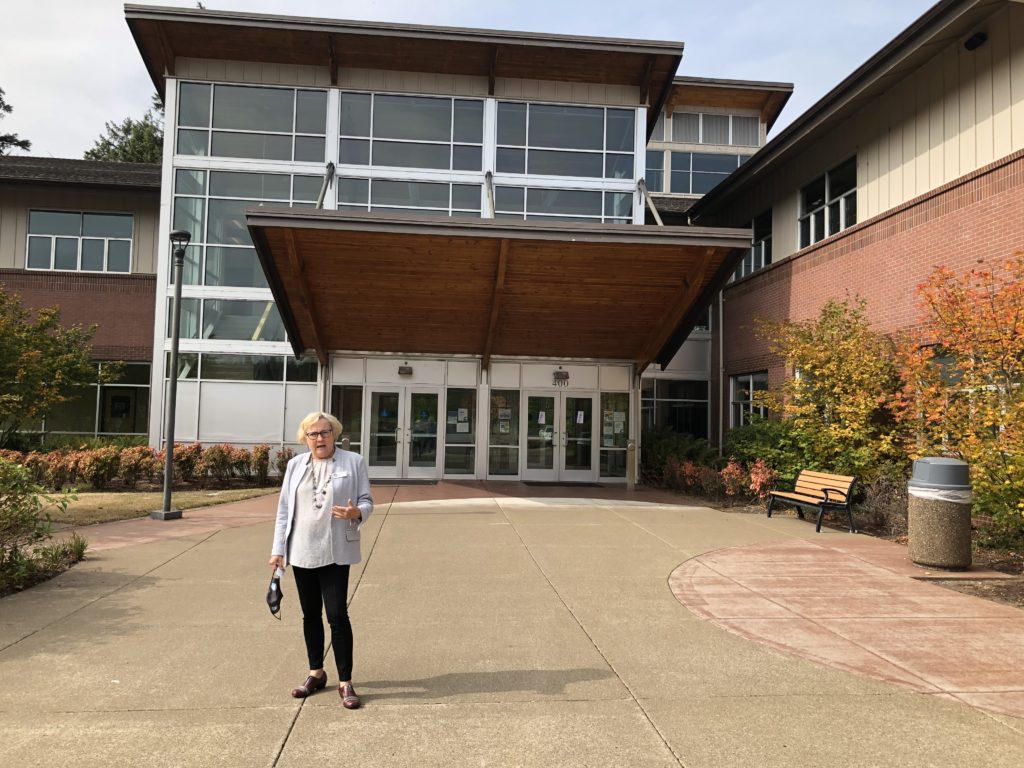
By SAMI EDGE/The Oregonian/OregonLive
Facing a $1.3 million budget deficit exacerbated by a sharp decline in enrollment during the COVID-19 pandemic, Clackamas Community College last spring considered making cuts to programs like nursing and welding.
The school narrowly avoided those cuts only because Congress approved pandemic relief dollars for community colleges and the state increased its college funding. The added money, coupled with savings and a tuition increase, allowed the college to balance its budget.
But the Oregon City-based college isn’t out of the woods yet.
Depending on enrollment and state funding, Clackamas may have to consider cuts again to balance its budget for the 2023-24 school year, said college president Tim Cook. With fewer than 4,500 full-time equivalent students, Clackamas’ enrollment is near a 40-year low.
“Had enrollment come back and things really reversed in that time, we’d be having a different conversation today – but that just hasn’t happened,” Cook said.
Community colleges across the state have yet to see enrollment rebound since it plummeted early in the pandemic, and no one knows when – or how much – it will climb back up. Federal funds that helped schools get by have run out and community colleges are unsure what their state funding levels will be as they plan ahead for 2023.
John Wykoff, deputy director of the Oregon Community College Association, said many schools are facing a “fiscal cliff” – if they’re not already over the edge. “They’re looking at having to make some pretty serious reductions,” Wykoff said.
Prone to boom or bust
Community colleges are highly susceptible to enrollment changes.
Oregon saw a 23% drop in enrollment from the fall of 2019 to 2021, compared to a drop of about 5% at the state’s public universities. Average yearly tuition and fees at an Oregon community college in 2021-22 were around $6,000 per student. Those funds make up about 23% of the budget for the average community college.
Enrollment has a direct impact on a school’s tuition revenue and its state funding, which is awarded based on student population. Community colleges also collect property tax revenues, which tend to be more stable.
Community college enrollment has historically followed the economy, college presidents say. During economic downturns and periods of high unemployment, more people turn to community colleges to earn new degrees or certificates. When unemployment is low and wages are high, like they are now, fewer students enroll.
The pandemic threw a wrench into those trends. When the U.S. experienced an economic downturn at the start of the pandemic, community college enrollment plummeted instead of increasing. And enrollment numbers remained low as employment rates recovered and wages increased.
As colleges eye budget cuts, they’re mindful that another recession could be on the horizon. Economists polled by the Financial Times speculate a recession will hit in 2023 or 2024. College presidents say they don’t want to cut programs that could be in demand if students return.
Before the pandemic, Oregon’s community colleges served more individual students than the state’s better known public universities — around 115,000 students in 2019. In the fall of 2021, community colleges were down to just 87,881 students compared to about 96,400 students at public universities. Many community college students attend part-time, so full-time-equivalent count was even lower at 19,244 students last fall.
Community colleges are more affordable than the four-year schools and more geographically diffused around the state, making them especially appealing to many rural and low-income Oregonians. Recent high school graduates can qualify for free tuition to the schools with the Oregon Promise grant, if they have a 2.0 GPA or higher.
Jim Pinkard, director of postsecondary finance for Oregon’s Higher Education Coordinating Commission, said many in higher education were preparing for the possibility of a recession before the pandemic hit. That didn’t work out as expected.
Pinkard thinks community colleges tried to maintain their staffing levels, despite steady declines in enrollment over the past decade, in case a recession drove in more students. They were instead met with accelerated enrollment loss.
“Now you’re in this position where, holy crap, what does the way home look like? If my enrollment keeps dropping as a result of the pandemic, am I overstaffed, am I over-resourced? Do I have enough people, do I have too few, and what do I do about it?” Pinkard said. “That’s the state of challenges that our institutions are facing.”
Enrollment, funding cuts differ
Enrollment drops and budget decisions vary across the state. Blue Mountain Community College, which has lost more than 42% of students since 2017, is in the process of cutting several faculty positions to help cover a $2 million deficit, a decision which has prompted campus protests in Pendleton.

Oregon Coast Community College, in Newport, saw a dip in students to start the pandemic, but expects to reach pre-pandemic enrollment levels in 2022-23, president Birgitte Ryslinge said.
The school’s small enrollment of around 450 full-time-equivalent students allowed Oregon Coast to make sure individual students didn’t fall through the cracks during learning disruptions, Ryslinge said. Oregon Coast also added new teaching and welding programs that were expected to boost enrollment but instead probably helped maintain student levels during the pandemic. Federal funds helped balance the budget amid a student decline and an uptick in costs, Ryslinge said, but the school needs to increase enrollment in the coming years to stay on track.
“We want to be cautiously optimistic and get on this trajectory for growth and get everyone behind that,” Ryslinge said. “If we’re not successful in that, we’re going to have to reassess at some point what’s sustainable.”
State funding uncertain
Enrollment is just part of the puzzle. Schools won’t know how much the Legislature will kick their way for the 2023-25 biennium until next spring, when Oregon will have a new governor and a host of new state lawmakers.
Last year, community colleges got an increase in state funding, with about $702 million going to the state’s 17 schools. Community college advocates have floated the notion of another big increase – up to a 44% bump – to help them cover costs and deficits.
The Oregon Community College Association proposed to the Higher Education Coordinating Commission this spring a $308.4 million funding increase for the 2023-25 biennium. The commission is responsible for submitting a funding proposal to the governor.
The colleges estimate it will take an increase of about $156.6 million just to cover their existing operating costs, given inflation and other price hikes. The community college association is proposing an additional $151.8 million in what Wykoff calls one-time “bridge funding” to help schools phase out federal COVID-19 relief dollars and cover deficit spending during the pandemic. The federal funds required schools to keep paying employees “to the greatest extent practicable,” Wykoff said, and many schools held back on cuts that might have otherwise been made.
He argues that the one-time bridge money would help colleges gradually reduce budgets instead of making cuts all at once, minimizing disruptions to students’ education as schools trim their spending to better align with reduced enrollment.
“The biggest concern is that the fiscal cliff will feel like a cliff for students,” Wykoff said.
The Higher Education Coordinating Commission has until September to decide how much it will recommend the state allocate for community colleges for the 2023-25 biennium. At the moment, the commissioners are considering a slate of options, from reducing community college funding to funding up to the 44% increase and beyond, Pinkard said. Commissioners are unlikely to recommend reducing funding levels, spokeswoman Endi Hartigan said.


